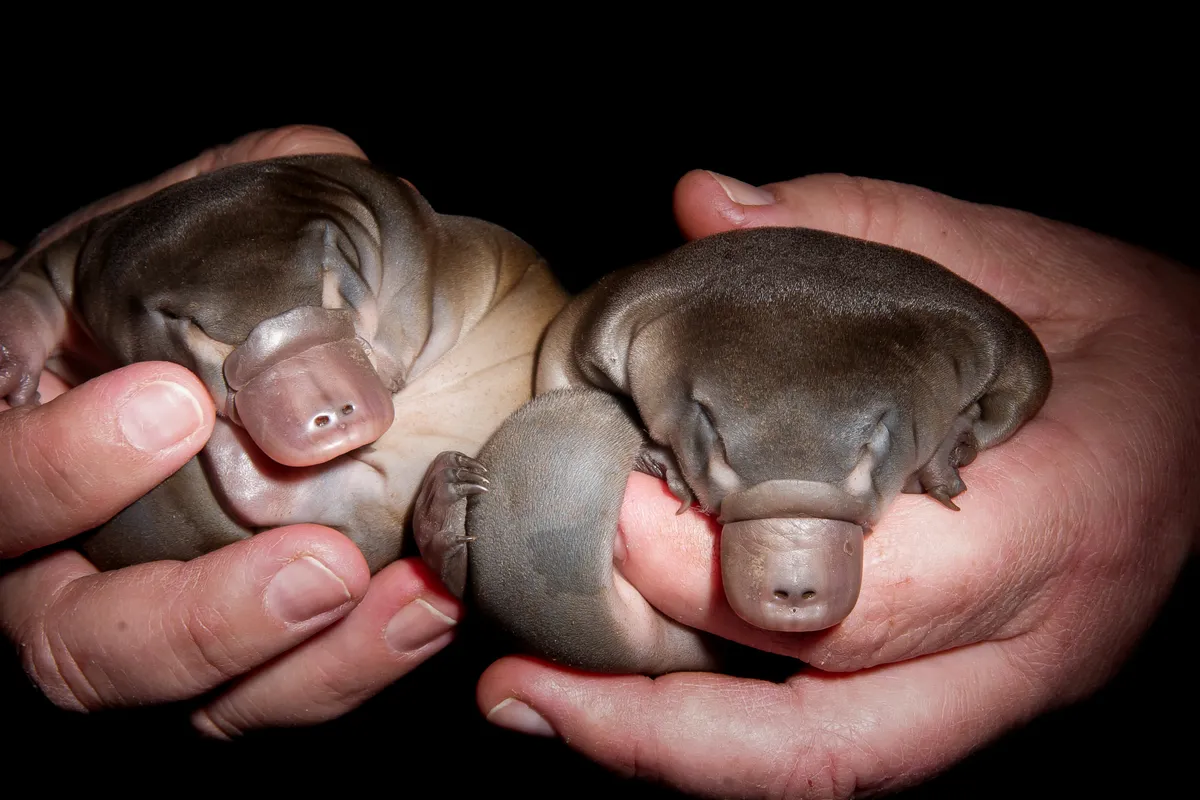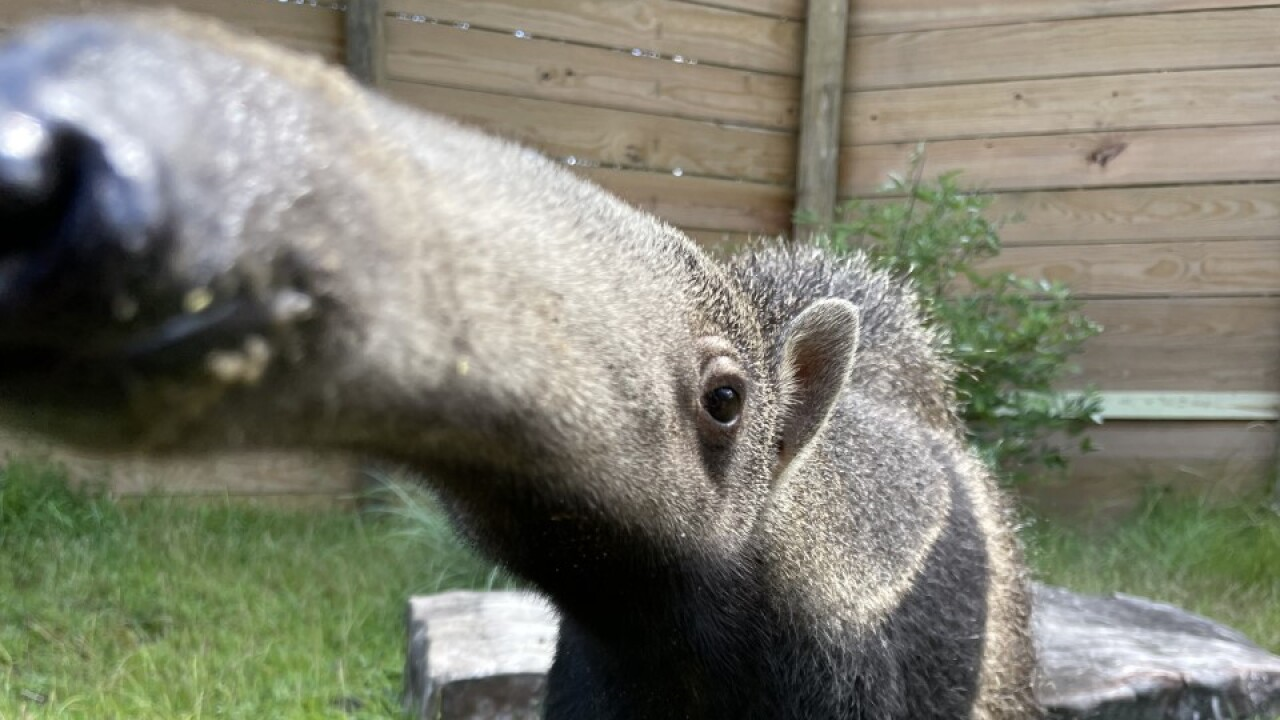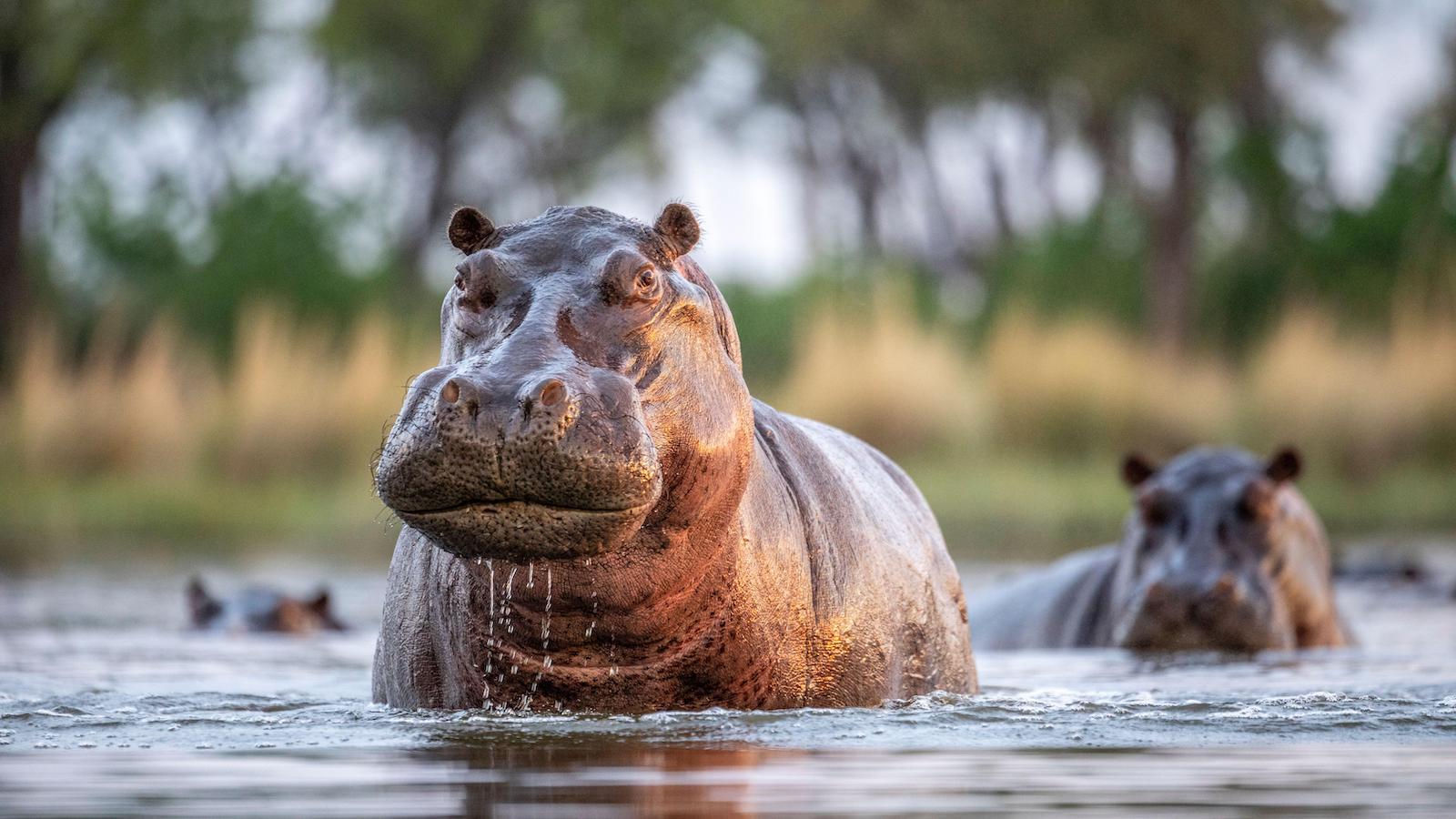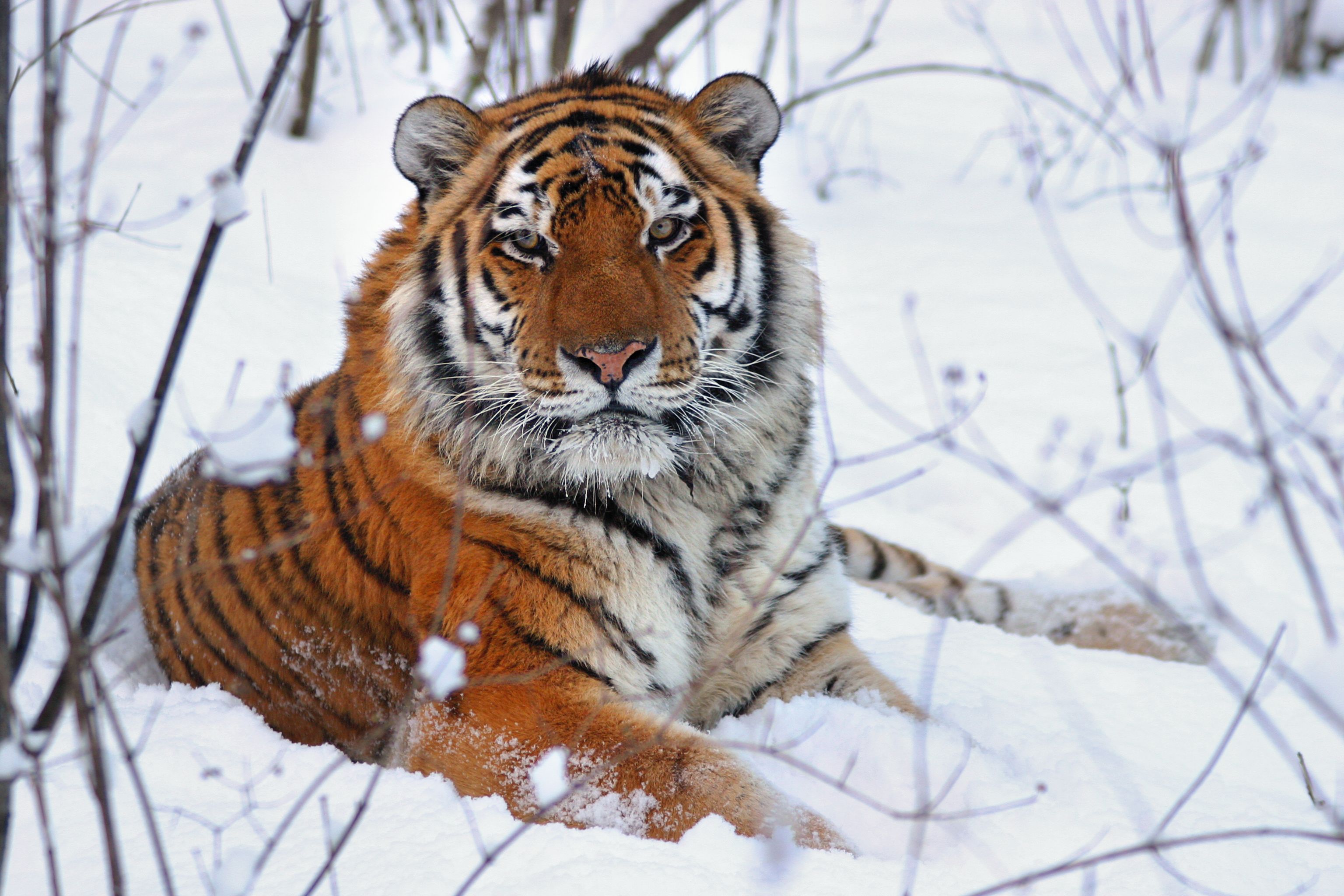-
Proboscis Monkey: The proboscis monkey, native to Southeast Asia, has a large, elongated nose that hangs down over its mouth, giving it a unique appearance.

-
Distinctive Nose:
- Proboscis monkeys are easily recognizable by their large, pendulous noses. In males, these noses can reach lengths of up to 7 inches (17.8 cm). The size of the nose is believed to be linked to sexual selection, where females may prefer males with larger noses.
-
Sexual Dimorphism:
- Proboscis monkeys exhibit significant sexual dimorphism, with males being noticeably larger than females. Besides the elongated nose, males also have a larger body size and more robust canine teeth compared to females.
-
Social Structure:
- Proboscis monkeys live in groups called troops, which typically consist of one dominant male, several females, and their offspring. The dominant male is responsible for leading and protecting the group.
-
Arboreal Lifestyle:
- Proboscis monkeys are arboreal, spending the majority of their time in trees. They are skilled climbers and leapers, and their long limbs and prehensile tails help them navigate through the forest canopy.
-
Unique Digestive System:
- These monkeys have a unique digestive system adapted to their herbivorous diet. They possess a specialized stomach with multiple chambers, allowing them to efficiently digest leaves and unripe fruit that are difficult to break down.
-
Vocalizations:
- Proboscis monkeys are known for their distinct vocalizations, which include various honks, calls, and grunts. These vocalizations play a crucial role in communication within the troop, helping them coordinate activities and warn of potential threats.
-
Endemic to Borneo:
- Proboscis monkeys are found only on the island of Borneo, which is shared by Malaysia, Indonesia, and Brunei. They inhabit coastal areas, mangrove forests, and riverine habitats.
-
Swimming Abilities:
- Unlike many other monkeys, proboscis monkeys are excellent swimmers. They have partially webbed feet, which aid them in swimming across rivers and navigating through their watery habitats. They are known to leap from trees into rivers, using swimming as a means of transportation and escape.
-
Conservation Status:
- Proboscis monkeys face threats to their populations due to habitat loss, primarily caused by deforestation, palm oil plantations, and human development. They are listed as Near Threatened on the International Union for Conservation of Nature (IUCN) Red List.
-
Ecological Role:
- Proboscis monkeys play a vital role in the ecosystem by contributing to seed dispersal. As they consume a variety of fruits and leaves, the seeds they excrete help in the regeneration of plant species, contributing to the overall health of the forest.
-
-
Elephant Seal: Male elephant seals have large, inflatable, and fleshy noses that resemble a trunk. During the breeding season, these "noses" are used to produce loud vocalizations.

Elephant seals are large marine mammals known for their massive size and distinctive trunk-like nose. There are two main species: the Northern elephant seal (Mirounga angustirostris) and the Southern elephant seal (Mirounga leonina). Here are some interesting facts about elephant seals:
-
Enormous Size:
- Elephant seals are among the largest marine mammals. Male Southern elephant seals are particularly massive, with some individuals weighing over 8,800 pounds (4,000 kg) and reaching lengths of up to 20 feet (6 meters). Northern elephant seals are slightly smaller.
-
Sexual Dimorphism:
- There is a significant size difference between male and female elephant seals. Male elephant seals, also known as bulls, are much larger than females, or cows. Bulls have a distinctive, elongated nose, giving them their name.
-
Vocalizations:
- Elephant seals are known for their vocalizations, which can include deep roars and grunts. Bulls use vocalizations to establish dominance during breeding season, and cows use them to communicate with their pups.
-
Dramatic Mating Rituals:
- During the breeding season, males engage in intense and often violent battles for dominance. The dominant males, known as alpha males, have the opportunity to mate with multiple females. The breeding colonies can be quite chaotic during this time.
-
Extended Breeding Season:
- Elephant seals have a prolonged breeding season, lasting several months. Mating typically occurs in late fall or winter, and pups are born about nine months later, with a peak in pupping season occurring a few weeks after the mating season.
-
Extended Oceanic Journeys:
- Elephant seals are known for their impressive long-distance oceanic journeys. They can travel thousands of miles across the open ocean, and some individuals have been tracked diving to depths exceeding 5,000 feet (1,500 meters).
-
Deep Diving Ability:
- Elephant seals are remarkable divers. They are capable of diving to great depths and can stay submerged for extended periods. Their ability to dive deep allows them to forage for prey, such as squid and fish, in the ocean depths.
-
Molt on Land:
- Elephant seals undergo an annual molt, during which they shed their fur and skin. Unlike some seals that molt in the water, elephant seals come ashore to molt. This process helps them maintain healthy and functional skin.
-
Blubber Storage:
- Elephant seals have a thick layer of blubber that helps them store energy and maintain buoyancy. This layer also provides insulation in cold waters, enabling them to thrive in diverse marine environments.
-
Conservation Success:
- Both Northern and Southern elephant seal populations were once severely depleted due to hunting for their blubber and other body parts. However, conservation efforts have led to a remarkable recovery, and both species have rebounded significantly.
-
-
Platypus: While not exactly "lips," the platypus has a unique bill that includes soft, sensitive skin that acts like lips. The platypus uses its bill to detect electrical signals from prey in the water.

Certainly! Here are some interesting facts about elephant seals:
-
Two Main Species:
- There are two primary species of elephant seals: the Northern elephant seal (Mirounga angustirostris) and the Southern elephant seal (Mirounga leonina). They are found in the North Pacific and the Southern Ocean, respectively.
-
Massive Size:
- Elephant seals are the largest seals and among the largest marine mammals. Male Southern elephant seals are particularly large, with some individuals weighing over 8,800 pounds (4,000 kg). Northern elephant seals are slightly smaller.
-
Sexual Dimorphism:
- There is a significant size difference between male and female elephant seals. Adult males, known as bulls, are much larger than females, or cows. The males also have a distinctive, trunk-like nose, which gives them their name.
-
Deep Divers:
- Elephant seals are exceptional divers and can reach depths of over 5,000 feet (1,500 meters). They can stay submerged for extended periods, often around 20 minutes, allowing them to forage for prey such as squid and fish in the deep ocean.
-
Extended Oceanic Journeys:
- These seals are known for their long-distance migrations across vast expanses of the ocean. They can travel thousands of miles in search of food, and some individuals have been tracked on journeys that span entire ocean basins.
-
Mating Battles:
- During the breeding season, male elephant seals engage in fierce battles for dominance. These battles involve vocalizations, posturing, and physical combat. The victorious males, known as alpha males, have the opportunity to mate with multiple females.
-
Pupping and Molting on Land:
- Elephant seals come ashore for two main reasons: to give birth to their pups and to molt. Pups are born with a dark, woolly coat, and adult seals undergo an annual molt, shedding their fur and skin.
-
Buoyant Blubber Layer:
- Elephant seals have a thick layer of blubber that helps with buoyancy in the water. This layer also serves as an energy store, insulation against cold temperatures, and a buffer during fasting periods.
-
Conservation Success:
- Both species of elephant seals faced severe population declines due to hunting for their blubber in the 19th century. Conservation efforts in the 20th century have led to a remarkable recovery, and populations have rebounded significantly.
-
Tourist Attractions:
- Elephant seal colonies are popular tourist attractions, drawing visitors who want to observe these fascinating marine mammals in their natural habitats. Viewing areas are often established to allow people to observe seals without disturbing them.
-
-
Anteater: Anteaters have tube-like mouths that are adapted for their diet of ants and termites. They use their long, sticky tongue to extract insects from nests.

Certainly! Here are some interesting facts about anteaters:
-
Specialized Diet:
- Anteaters are insectivorous mammals that primarily feed on ants and termites. Their long snouts and tongues are specially adapted for extracting insects from anthills and termite mounds.
-
Tongue Length:
- The tongue of an anteater can extend up to two feet (61 cm) or more. It is covered in tiny, backward-facing spines that help capture and secure the insects it feeds on.
-
No Teeth:
- Anteaters lack teeth. Instead, they use their strong claws to tear open ant and termite nests, and their specialized tongue efficiently extracts insects for consumption.
-
Variety of Species:
- There are four species of anteaters: the giant anteater, the silky anteater, the southern tamandua, and the northern tamandua. The giant anteater is the largest and most well-known species.
-
Giant Anteater Size:
- The giant anteater (Myrmecophaga tridactyla) is the largest of the anteater species. Adult giant anteaters can reach lengths of 6 to 8 feet (1.8 to 2.4 meters) from the tip of their snout to the end of their tail.
-
Nocturnal and Solitary:
- Anteaters are primarily nocturnal, being more active during the night. They are often solitary animals, and individuals may have large home ranges to find enough food.
-
Excellent Sense of Smell:
- Anteaters have an excellent sense of smell, which helps them locate ant and termite colonies. Their keen sense of smell, combined with strong claws and long tongues, makes them efficient insect hunters.
-
Efficient Eaters:
- Giant anteaters can consume up to 30,000 ants or termites in a single day. Their diet is highly specialized, and they play a vital role in controlling insect populations.
-
Unique Walk:
- Anteaters have a distinctive way of walking known as the "two-pole gait." They walk on their knuckles with their claws curled up to avoid wearing them down, creating a distinctive and efficient mode of movement.
-
Threats and Conservation:
- Anteaters face threats such as habitat loss, road mortality, and illegal wildlife trade. Conservation efforts are in place to protect their natural habitats and raise awareness about the importance of preserving these unique mammals.
-
Defense Mechanism:
- In the wild, anteaters are typically non-aggressive, but when threatened, they may rear up on their hind legs and use their powerful forelimbs and claws for defense. They can be formidable opponents against predators such as jaguars or pumas.
-
-
Tube-Lipped Nectar Bat: Found in Central and South America, this bat species has an unusually long, tube-like tongue that it uses to feed on nectar from flowers.

The tube-lipped nectar bat (Anoura fistulata) is a species of bat known for its exceptionally long tongue adapted for feeding on nectar. Here are some interesting facts about the tube-lipped nectar bat:
-
Extraordinary Tongue Length:
- The tube-lipped nectar bat possesses an extraordinarily long tongue, which can extend up to 8.5 centimeters (3.3 inches). This specialized tongue is designed for reaching deep into long-tubed flowers to extract nectar.
-
Endemic to Ecuador:
- The tube-lipped nectar bat is found exclusively in the cloud forests of the Andes in Ecuador. Its habitat includes areas with an abundance of flowering plants, particularly those with long tubular flowers.
-
Specialized Diet:
- As the name suggests, the tube-lipped nectar bat primarily feeds on nectar. It is an important pollinator for certain plant species in its native habitat, facilitating the transfer of pollen between flowers as it feeds.
-
Nocturnal Lifestyle:
- Like many bats, the tube-lipped nectar bat is nocturnal. It is most active during the night when it forages for nectar and possibly insects. During the day, it roosts in sheltered locations.
-
Unusual Foraging Behavior:
- This bat exhibits a unique foraging behavior where it hovers in front of flowers while feeding. Its long tongue allows it to reach the nectar concealed within the long tubes of certain flowers.
-
Social Structure:
- Tube-lipped nectar bats are known to form social groups, roosting together in colonies. These colonies may consist of both males and females, and the bats often share information about foraging locations.
-
Cryptic Coloration:
- The tube-lipped nectar bat has a cryptic coloration that helps it blend into its forested surroundings. Its fur can vary in color, ranging from brown to gray, providing camouflage among the foliage.
-
Mating Behavior:
- Little is known about the specific mating behavior of the tube-lipped nectar bat. However, like many bat species, they likely engage in courtship rituals and mate during certain times of the year.
-
Conservation Concerns:
- The tube-lipped nectar bat faces potential threats due to habitat loss and degradation. Conservation efforts are important to protect its specialized habitat and ensure the survival of this unique species.
-
Scientific Discovery:
- The tube-lipped nectar bat was officially described as a new species in 2005 by scientists Rodrigo A. Medellín and Nayara Macedo. Its discovery highlighted the importance of biodiversity research and conservation in the cloud forests of Ecuador.
-
-
Narwhal: The narwhal, often referred to as the "unicorn of the sea," has a long, spiral tooth that can grow up to 10 feet long. This tooth is actually an elongated canine tooth.

-
Distinctive Tusk:
- Narwhals are best known for their long tusks, which are actually elongated teeth. The tusks can reach lengths of up to 10 feet (3 meters) or more. They are spiral-shaped and can have a helical structure.
-
Toothed Whales:
- Narwhals are toothed whales and are related to belugas, orcas, and bottlenose dolphins. Despite their impressive tusks, narwhals have fewer teeth than most other toothed whale species.
-
Unicorn of the Sea:
- Due to their unique appearance and the long, spiral tusks, narwhals are often referred to as the "unicorns of the sea." In medieval times, the tusks were sometimes sold as unicorn horns, contributing to mythical beliefs.
-
Arctic Dwellers:
- Narwhals are Arctic whales and are found in the cold waters of the Arctic Ocean. They are known to inhabit areas with sea ice and are often associated with the pack ice.
-
Migratory Behavior:
- Narwhals are known for their long-distance migrations. They move between their summer feeding grounds and winter breeding and calving areas, traveling hundreds or even thousands of kilometers.
-
Diet:
- The primary diet of narwhals consists of fish, squid, and shrimp. They use their tusks to stun fish before consuming them. Narwhals are deep divers, capable of reaching depths of over 4,000 feet (1,200 meters).
-
Social Structure:
- Narwhals often travel in groups called pods. These pods can vary in size, ranging from a few individuals to several dozen. Pods may include both males and females, but males are known to form more distinct groups.
-
Tusk Purpose:
- While the exact purpose of the narwhal's tusk is not fully understood, it is believed to have multiple functions. It may be used for breaking ice, hunting, and as a sensory organ for detecting changes in the environment, including water temperature and salinity.
-
Communication:
- Narwhals are known for their vocalizations, including clicks, whistles, and pulsed sounds. These vocalizations are thought to be important for communication within the pod.
-
Conservation Concerns:
- Narwhals face threats such as climate change, loss of sea ice, and potential disturbances from human activities in the Arctic. Conservation efforts are underway to better understand and protect these unique marine mammals.
-
-
Star-Nosed Mole: The star-nosed mole has a unique, star-shaped structure around its nose, which is extremely sensitive to touch. It uses this feature to navigate and identify prey in its underground habitat.

-
Unique Nose:
- The most striking feature of the star-nosed mole is its nose, which has 22 fleshy appendages arranged in a star-like pattern. These appendages, called rays, are extremely sensitive and help the mole detect prey in its underground environment.
-
Echolocation:
- Star-nosed moles are known to use echolocation to navigate and locate prey. They emit clicking sounds and interpret the echoes to determine the location, size, and texture of objects around them.
-
Fast Eaters:
- The star-nosed mole is an incredibly fast eater. It can identify and consume small prey items, such as insects, in less than a quarter of a second. The sensitive nose aids in quickly assessing and capturing prey.
-
Semi-Aquatic Lifestyle:
- While primarily terrestrial, star-nosed moles are also adept swimmers. They are known to hunt in water, and their dense fur provides buoyancy, allowing them to move efficiently through aquatic environments.
-
Habitat and Range:
- Star-nosed moles are native to eastern North America and are commonly found in wet lowland areas, such as marshes, meadows, and along stream banks. They are skilled burrowers and construct intricate tunnel systems.
-
Nocturnal Behavior:
- These moles are primarily nocturnal, meaning they are most active during the night. They spend much of their time foraging for food in their underground tunnels.
-
Social Creatures:
- Star-nosed moles are believed to be more social than many other mole species. They are known to share tunnels and may engage in cooperative digging and foraging activities.
-
Excellent Swimmers:
- Star-nosed moles are efficient swimmers, and they are capable of moving through water with ease. They use their large, webbed feet to paddle, and their tail aids in steering.
-
Short Lifespan:
- Star-nosed moles have a relatively short lifespan compared to some other small mammals. In the wild, they typically live for about 2 to 3 years.
-
Efficient Tunnellers:
- These moles are skilled at tunneling, and their star-shaped nose aids in this process. They use their powerful front limbs to dig and their sensitive nose to locate prey and navigate their underground habitat.
-
-
Parrotfish: Parrotfish have beak-like mouths that are fused with teeth, creating a powerful tool for scraping algae and coral from rocks. Their lips play a crucial role in feeding and maintaining coral reef ecosystems.

-
Colorful Appearance:
- Parrotfish are renowned for their bright and vivid colors. Their vibrant hues often include shades of blue, green, yellow, and red. The colors are not only visually striking but also serve as a form of camouflage in the coral reef environment.
-
Beak-Like Mouth:
- The unique beak-shaped mouth of parrotfish is a distinguishing feature. This beak is composed of fused teeth that form a tough, bird-like structure. It is used for grazing on algae and coral, and some species also feed on invertebrates.
-
Herbivorous Diet:
- Parrotfish are primarily herbivores. They feed on algae and other plant material found on coral reefs. Their feeding activities play a crucial role in maintaining the health of coral reefs by preventing the overgrowth of algae that can smother corals.
-
Coral Crunchers:
- While grazing on algae, parrotfish inadvertently ingest small bits of coral. The coral is ground up by their powerful jaws and then excreted as fine sand. This process contributes to the production of coral sand, which forms sandy beaches and helps in the overall health of coral reef ecosystems.
-
Schooling Behavior:
- Parrotfish often exhibit schooling behavior, especially during feeding and nighttime resting. In some species, large schools of parrotfish can be observed, providing protection from predators.
-
Sexual Dimorphism:
- In some parrotfish species, there is sexual dimorphism in coloration. Males and females may exhibit different color patterns or have different stages of color development, which is often linked to their reproductive roles.
-
Sequential Hermaphrodites:
- Many parrotfish are known to be protandrous sequential hermaphrodites. This means they start life as males and may later change sex to become females. The transition is usually triggered by social factors, such as the absence of dominant males.
-
Predation and Defense:
- Parrotfish face predation from various marine predators, including sharks, barracudas, and moray eels. Their vibrant coloration, combined with their ability to quickly hide in crevices within the coral reef, serves as a form of defense against predators.
-
Nocturnal Behavior:
- Some parrotfish species exhibit nocturnal behavior. During the night, they rest in crevices and alcoves within the coral reef, providing a time of reduced activity and feeding.
-
Global Distribution:
- Parrotfish are found in tropical and subtropical waters around the world, primarily in coral reef ecosystems. They contribute to the biodiversity and ecological balance of these marine environments.
-
-
Harpy Eagle: The harpy eagle has distinct facial features, including a facial disk and a large, hooked beak. The structure of its beak aids in capturing and consuming prey, often consisting of monkeys and other large birds.

-
Majestic Size:
- The Harpy Eagle is one of the largest eagles globally, with a wingspan that can reach up to 7 feet (2.2 meters). Females are generally larger than males.
-
Powerful Build:
- These eagles have a robust and powerful build, featuring strong legs and large, hooked talons that can measure up to 5 inches (13 centimeters) in length. Their legs are so powerful that they can exert a pressure strong enough to crush the bones of their prey.
-
Dense Forest Habitat:
- Harpy Eagles are primarily found in the tropical rainforests of Central and South America. They inhabit dense, remote, and undisturbed forests, often in mountainous regions.
-
Top Predator:
- As apex predators, Harpy Eagles sit at the top of their food chain. They are skilled hunters and are known to prey on a variety of animals, including tree-dwelling mammals like monkeys and sloths, as well as birds.
-
Distinctive Appearance:
- Harpy Eagles have a distinctive appearance with a crown of feathers on their head that can be raised or lowered. They also have a prominent facial disk and bold black and white markings on their body, giving them a striking and regal appearance.
-
Monogamous Pairing:
- Harpy Eagles are known for forming monogamous pairs that mate for life. They typically raise one chick at a time, investing considerable effort in the care and upbringing of their offspring.
-
Nesting Habits:
- The nesting habits of Harpy Eagles are fascinating. They build large nests high in the canopy of tall trees, often choosing emergent trees that tower above the forest. The nests can be as large as 6 feet (1.8 meters) in diameter.
-
Long Lifespan:
- In the wild, Harpy Eagles can have a lifespan of around 25 to 35 years. However, their population is threatened by habitat loss and other human-induced pressures.
-
Low Reproductive Rate:
- Harpy Eagles have a low reproductive rate, with females typically producing one egg every two to three years. The slow reproductive rate makes them vulnerable to population decline.
-
Conservation Concerns:
- The Harpy Eagle is considered near-threatened due to habitat loss, deforestation, and hunting. Conservation efforts are underway to protect their habitats and raise awareness about the importance of preserving these magnificent birds.
-
-
Hippopotamus: Hippos have large, thick lips that are adapted for grazing on grass. Despite their seemingly comical appearance, hippos are known for their powerful jaws and can be quite aggressive.

-
Mighty Size:
- Hippos are among the largest land mammals. Adult males can weigh up to 3,300 pounds (1,500 kilograms), and females are slightly smaller. Despite their massive size, they are surprisingly agile in the water.
-
Semi-Aquatic Lifestyle:
- Hippos spend a significant amount of time in the water to keep their massive bodies cool. They are excellent swimmers and can hold their breath for several minutes. However, they cannot float and walk or stand on the riverbed.
-
Territorial and Aggressive:
- Hippos are known for their territorial and aggressive behavior, especially in protecting their aquatic territories. They have powerful jaws with large canine teeth and can be extremely dangerous to humans, often considered one of the most aggressive large animals in Africa.
-
Herbivorous Diet:
- Despite their fearsome appearance, hippos are herbivores. They primarily feed on grasses, spending a significant portion of their nights grazing on land. They can consume large amounts of vegetation to sustain their massive bodies.
-
Unique Skin Secretion:
- Hippos secrete a reddish, oily substance known as "blood sweat." This secretion is a natural sunscreen that helps protect their sensitive skin from the harsh African sun. The name "blood sweat" is somewhat misleading, as it is neither blood nor sweat but a unique secretion.
-
Night Grazers:
- Hippos are primarily nocturnal grazers, and they usually leave the water at night to feed on grasses. This behavior is partially influenced by the cooler temperatures during the night.
-
Social Structure:
- Hippos are social animals and often live in groups, called pods, that can range from a few individuals to over 100 members. These groups are led by a dominant male.
-
Birth and Maternal Care:
- Female hippos give birth to a single calf after a gestation period of about 8 months. Calves are born underwater and quickly learn to swim. The mother is protective of her calf and keeps it close by for the first few weeks.
-
Fast Runners:
- Despite their hefty build, hippos are surprisingly fast runners on land. They can reach speeds of up to 30 miles per hour (48 kilometers per hour) over short distances, making them agile and formidable on land as well as in the water.
-
Conservation Status:
- The common hippopotamus is classified as vulnerable by the International Union for Conservation of Nature (IUCN) due to habitat loss, poaching, and conflicts with humans. Conservation efforts are ongoing to protect and manage hippo populations in the wild.
-
These examples showcase the diversity of adaptations that animals have evolved for specific ecological roles, whether for feeding, communication, or environmental interaction.












